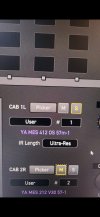Yes, a high cut (low pass filter) cuts off all the frequencies above the frequency you set it at, and a low cut (high pass filter) cuts off the frequencies south of where you set it. They're a quick way to shave off a lot of sonic information.Thank you for your advice!
Did I understand this correctly - using any cuts on an impulse responce affects the IR itself and using a PEQ block after the cabinet affects the hole tone without destructing the IR and its natural frequency range?
If you don't use any low/high cuts and use a PEQ to reduce a targeted frequency, it only affects the selected frequency and lets everything else pass through naturally.

